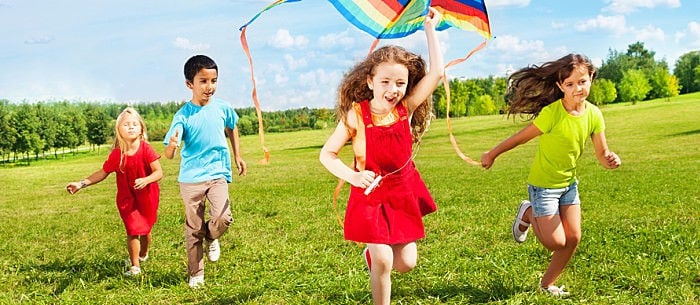“Hey Mom, look at me!” Your 4-year-old is proudly perched at the top of the jungle gym. Just a few months ago, she never would have dared to climb so high, and your heart jumps. But suddenly she seems to be bursting with enthusiasm for experimenting with her body’s physical development.
The fifth year of life is an exciting time for young children and their parents. “There’s a developmental burst happening as your kid is getting ready for kindergarten,” explains Tracy Stackhouse, a pediatric occupational therapist and co-founder/president of Developmental FX. “Kids are starting to have a real command over how their bodies interact with their environment.” This year, your child will become both more physically adept and more functionally independent, as the American Academy of Pediatrics (AAP) emphasizes.
And read
our guide to developmental milestones for kids
.
Growing in Leaps and Bounds
At this point in your child’s physical development, her gross motor skills still get a workout through play. At the playground, she’ll be swinging and climbing. According to the AAP, she can easily master a tricycle or balance bike, and possibly even a two-wheeler.
Your child’s balance is also improving. Stackhouse states that standing on one foot for even 35 seconds is enough to show your child’s emerging balancing skills. According to physical therapist Leida Lewis, assistant branch director at North Shore Pediatric Therapy, some children have difficulty balancing on command. These children can demonstrate their growing skills by galloping, then hopping and, eventually, skipping.
Your child’s hands will be also developing and preparing to eventually learn to write. She’ll be coloring more efficiently, drawing basic shapes, and even writing the letters in her name. Children who aren’t interested in drawing or writing can demonstrate their fine motor skills in other ways, making complex Lego structures, building puzzles or manipulating small objects.
Your child’s desire for independence will also push her to develop functional skills that require more advanced physical development. By age 5, she should dress herself — securing buttons and zipping zippers. (Shoe tying may still be difficult.) She should be gradually becoming more proficient with using a fork and spoon. She can use the bathroom independently by age 5.
Jump-Start Your Child’s Physical Development
Looking for ways to help your child meet these physical milestones? First, don’t be afraid to let your child struggle. Yes, it may be easier to get your child dressed yourself — but she won’t develop these essential skills if you do. Instead, let her try it herself before you jump in to help. Ask gently if she would like some help when you see she’s starting to get frustrated.
Second, watch out for technology overuse. Writing on an iPad screen is fun, but it doesn’t practice the same skills as manipulating a crayon, says Lewis. Many kids today also lack stamina and miss the chance to develop gross motor skills because of screen time. While it’s fine to let your preschooler experience technology, make sure it’s not taking the place of physical activity.
And of course, make it fun. Your child doesn’t like the playground? Maybe running around in the yard is more up her alley. No interest in drawing shapes or pictures? Give her a building set or a puzzle instead. If she struggles with specific motor skills, she might not find certain activities much fun, explains Lewis. Encourage your child to reach for those milestones without piling on the pressure. A range of activities will help kids with different development progression, but they all work toward the overall progress and growth.
Remember the Big Picture
Both Stackhouse and Lewis emphasize that parents and caregivers should look at the big picture, rather than obsessing about a specific physical milestone. “At this age, there’s a huge range of normal,” emphasizes Stackhouse. “If your child hasn’t quite settled into using markers and crayons well, but uses a washcloth to scrub her face and can pick up blocks to build a tower, you can rest assured that she is doing the necessary developmental work to refine her hand skills in preparation for school.” In other words, if your child isn’t quite reaching a specific milestone, watch for steady progress throughout this year. If your child is improving slowly, her gross and fine motor skills are probably right on track.
Check out our Overview of Milestones for 4 Year Olds.
Keren Perles is a parenting educator and freelance writer who loves digging up practical parenting information to share with other parents in cyberspace. As a parent of three lively young boys, she knows that parenting isn’t just a job — it’s a lifetime pursuit.
* This article is for general informational purposes only. It is not intended nor implied to be providing medical advice and is not a substitute for such advice. The reader should always consult a health care provider concerning any medical condition or treatment plan. Neither Care.com nor the author assumes any responsibility or liability with respect to use of any information contained herein.


